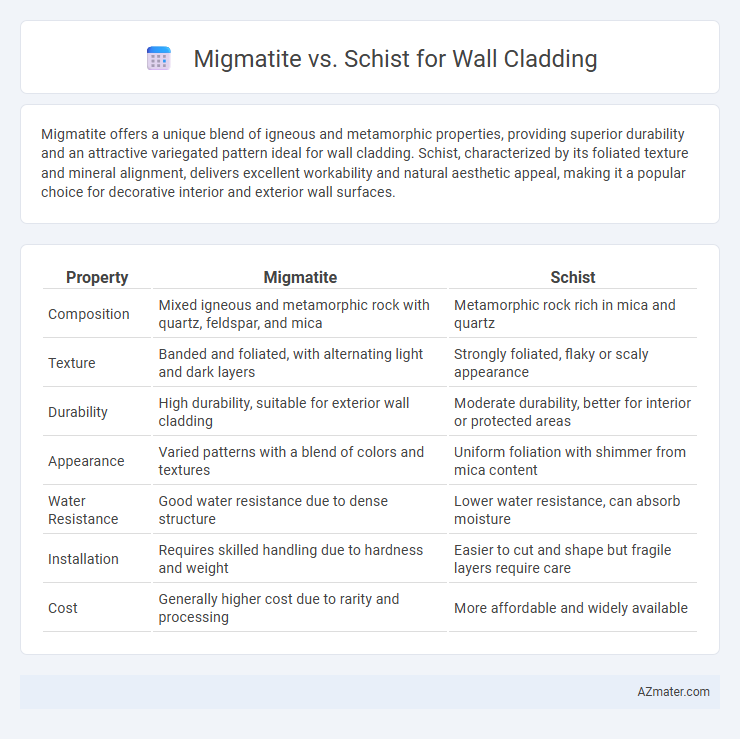Migmatite offers a unique blend of igneous and metamorphic properties, providing superior durability and an attractive variegated pattern ideal for wall cladding. Schist, characterized by its foliated texture and mineral alignment, delivers excellent workability and natural aesthetic appeal, making it a popular choice for decorative interior and exterior wall surfaces.
Table of Comparison
| Property | Migmatite | Schist |
|---|---|---|
| Composition | Mixed igneous and metamorphic rock with quartz, feldspar, and mica | Metamorphic rock rich in mica and quartz |
| Texture | Banded and foliated, with alternating light and dark layers | Strongly foliated, flaky or scaly appearance |
| Durability | High durability, suitable for exterior wall cladding | Moderate durability, better for interior or protected areas |
| Appearance | Varied patterns with a blend of colors and textures | Uniform foliation with shimmer from mica content |
| Water Resistance | Good water resistance due to dense structure | Lower water resistance, can absorb moisture |
| Installation | Requires skilled handling due to hardness and weight | Easier to cut and shape but fragile layers require care |
| Cost | Generally higher cost due to rarity and processing | More affordable and widely available |
Introduction to Migmatite and Schist
Migmatite and schist are metamorphic rocks commonly used for wall cladding due to their durability and aesthetic appeal. Migmatite features a unique composition with both igneous and metamorphic characteristics, creating a distinct banded or mottled appearance ideal for decorative surfaces. Schist, characterized by its foliated texture and rich mineral content like mica and quartz, offers excellent workability and an attractive shimmer that enhances cladding designs.
Geological Formation and Composition
Migmatite, formed through partial melting of metamorphic rocks, exhibits a mixed composition of igneous and metamorphic minerals, typically including quartz, feldspar, and biotite, creating a heterogeneous, banded appearance ideal for unique wall cladding textures. Schist, primarily composed of flaky mica minerals like biotite or muscovite, results from medium to high-grade regional metamorphism, characterized by pronounced foliation and a more uniform mineral alignment that delivers a consistent, layered aesthetic for cladding applications. The geological formation of migmatite's partial melting imparts greater structural complexity, while schist's foliation enhances mechanical strength, influencing their suitability and visual impact as natural wall cladding materials.
Visual Appearance and Texture
Migmatite features a striking, marbled appearance with intricate banding and a mix of light and dark mineral layers, creating a dynamic, natural texture ideal for unique wall cladding designs. Schist presents a foliated texture with visible mineral grains, often shimmering due to mica content, offering a more uniform but richly textured surface that enhances visual depth in architectural applications. Both materials provide durability, but Migmatite's complex patterns lend a more artistic aesthetic, while Schist's consistent layering suits elegant, refined finishes.
Durability and Weather Resistance
Migmatite offers superior durability and weather resistance compared to schist due to its partial melting and recrystallization, resulting in a denser, more robust rock structure ideal for wall cladding. Schist, while attractive with its foliated texture and ease of splitting, is more prone to weathering and erosion under harsh environmental conditions, affecting its longevity on exterior surfaces. Selecting migmatite for wall cladding ensures enhanced performance in resisting moisture, temperature fluctuations, and mechanical wear over time.
Color Variations and Aesthetic Appeal
Migmatite offers a unique blend of light and dark mineral patterns, creating striking, mottled color variations that enhance wall cladding with a natural, dynamic aesthetic. Schist features pronounced foliated textures and often vibrant color ranges including greens, grays, and golds, adding rich visual depth and elegance to surfaces. Both stones provide durable, visually appealing options, with Migmatite's swirling patterns contrasted by Schist's layered shimmer, influencing design choices based on desired ambiance and style.
Weight and Workability for Installation
Migmatite, with its higher density and irregular banding, tends to be heavier and more challenging to cut, impacting the ease of installation for wall cladding. Schist offers a lighter weight and greater workability due to its foliated texture, allowing for easier cutting and fitting during installation. Choosing schist can reduce labor time and structural support requirements compared to migmatite.
Maintenance Requirements
Migmatite offers superior durability and resistance to weathering, requiring minimal maintenance compared to schist, which is more prone to flaking and necessitates regular sealing and cleaning to preserve its appearance. Schist is softer and more susceptible to moisture penetration, often leading to increased upkeep, including repairs and treatment to prevent moss or algae growth, particularly in humid environments. Choosing migmatite for wall cladding reduces long-term maintenance costs and efforts due to its harder composition and enhanced structural integrity.
Cost Comparison and Availability
Migmatite generally costs more than schist due to its complex formation and rarity, making it a premium choice for wall cladding projects. Schist is more widely available and easier to source, resulting in lower prices and greater accessibility for large-scale installations. Pricing can vary based on regional supply and quarrying expenses, with schist often favored in budget-conscious designs.
Environmental Impact and Sustainability
Migmatite offers higher durability and natural resistance to weathering, reducing the need for frequent replacement and lowering long-term environmental impact. Schist, while aesthetically versatile and abundant, often requires more intensive quarrying and processing, increasing energy consumption and carbon emissions. Choosing migmatite for wall cladding supports sustainability by minimizing resource extraction and enhancing building longevity.
Best Applications and Design Considerations
Migmatite offers exceptional durability and unique banded patterns ideal for high-traffic wall cladding in commercial and luxury residential spaces, providing natural aesthetics with enhanced structural integrity. Schist, with its foliated texture and metallic sheen, suits decorative interior walls where visual impact and texture variation are prioritized over structural strength. Design considerations include selecting migmatite for load-bearing exterior facades due to superior resistance to weathering, while schist is preferred for accent walls requiring artistry and ease of installation.

Infographic: Migmatite vs Schist for Wall Cladding
 azmater.com
azmater.com